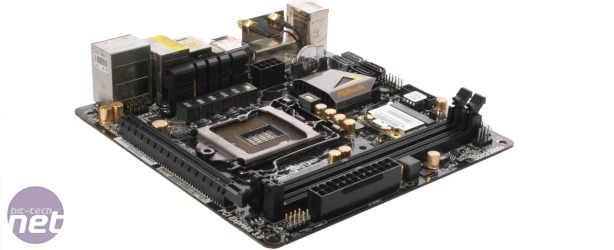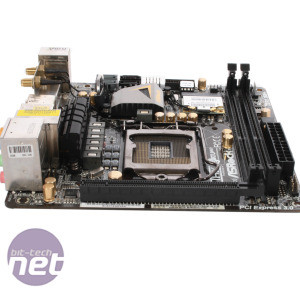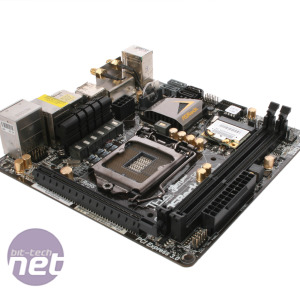ASRock Z77E-ITX
Manufacturer: ASRockUK price (as reviewed): £123.98 (inc VAT)
US price (as reviewed): $149.99 (ex tax)
In terms of core spec, the ASRock Z77E-ITX is very similar to the Asus board that we’ve just looked at, though that’s hardly surprising given the limited amount of space available for extras on mini-ITX boards. It’s fair to say that the layout of the PCB is significantly more busy however, a situation obviously down to the fact that the Z77E’s VRM circuitry is located in its traditional position around the CPU socket, rather than on a separate daughterboard.
That’s not prevented ASRock making the Z77E into a looker though, as its brushed gun metal heatsinks and gold and black accents look great, lending the board a quietly menacing persona. The same gold coloured capacitors that ASRock uses on its high end ATX motherboards are also present, adding a little extra bling to proceedings.
The Z77E is well connected for such a small board, but it still loses out to the Asus slightly in this regard as is only boasts five SATA ports (2 x 6Gbps, 2 x 3Gbps, 1 x eSATA) and six of each USB flavour. It also lacks the integrated Bluetooth of the Asus board, though it’s worth noting that it does come with a full complement of surround audio ports, unlike the more expensive Z77-I.
Unfortunately, building a PC around the Z77E is a tricky task, as the aforementioned PCB clutter has led to some pretty puzzling design choices. For a start the CPU socket is located towards the bottom of the board, meaning any CPU cooler you use is going to be very close to the back of your graphics card (if you’re using one). The EPS12V connector is also stranded mid-board, meaning you’re likely to have a nice thick PSU cable straddling the board and generally getting in the way.
Another slight foible is the location of the SATA ports, which are in the top left hand section of the Z77E. This isn’t unheard of on mini-ITX boards, but it’s a more awkward position that the more traditional bottom right arrangement that the Asus board uses.
Overclocking
The world of mini-ITX motherboards isn’t usually a hotbed of overclocking activity, but we had high hopes for the two boards we’re looking at here as they’re both premium products aimed at enthusiasts. With this in mind, we were fairly bullish with our settings, jumping straight in at a clock speed of 4.6GHz.Pleasingly, both boards handled this with aplomb, and it was then a relatively simple task to edge the CPU up to its 4.8GHz maximum, with both boards requiring a Vcore of 1.28V to achieve this. As we’ve come to expect from Ivy Bridge, heat played its part too - we saw peak CPU temperatures in the high 90s on both boards, though both were perfectly stable.
Overclocking the boards also gave us a good look at both their EFIs, and in this regard the Asus comes out a smidgen ahead as it contained more options (the ASRock board lacked a manual CPU PLL voltage for example) and was laid out in a more intuitive manner.
ASRock Z77E-ITX Specifications
- Chipset Intel Z77
- CPU support LGA1155 Core i3, Core i5 and Core i7
- Memory support 2 slots: max 16GB DDR3 (2,800MHz)
- Expansion slots One 16x PCI-E 3.0 slot
- Sound 8-channel HD audio via Realtek ALC898
- Networking Broadcom BCM57781 Gigabit LAN, 802.11 a/b/g/n WiFi
- Overclocking: Base Clock max: 150MHz, CPU multiplier: 16-63, max voltages, CPU 1.7V, RAM 1.8V, VCSSA 1.208V
- Ports 2 x SATA 6Gbps, 2 x SATA 3Gbps, 6 x USB 2, 6 x USB 3, LAN, Optical S/PDIF audio out, line in, mic, 3 x surround audio, eSATA, DisplayPort, DVI-D, HDMI
- Dimensions (mm) 170 x 170 (mini-ITX)

MSI MPG Velox 100R Chassis Review
October 14 2021 | 15:04












Want to comment? Please log in.